Ijraset Journal For Research in Applied Science and Engineering Technology
- Home / Ijraset
- On This Page
- Abstract
- Introduction
- References
- Copyright
Ginger Processing and It’s Value Addition
Authors: Avijeet Nayak, Debendra Pradhan, Dibyadarshan Nayak, Dr. Satyananda Swain, Prof. Gayatri Mohanty
DOI Link: https://doi.org/10.22214/ijraset.2022.42644
Certificate: View Certificate
Abstract
Ginger (Zingiber officinale) is a blooming plant whose rhizome, ginger root, or ginger, is generally utilized as a flavor and a people medication. Ginger is stacked with cell reinforcements, intensifies that forestall pressure and harm to your body\'s DNA. They might assist your body with warding off persistent sicknesses like hypertension, coronary illness, and infections of the lungs, in addition, to advancing solid maturing. Specialists suggest consuming a limit of 3-4 grams of ginger concentrates each day. Assuming that you\'re pregnant, don\'t consume more than 1 gram of ginger concentrate each day. Ginger isn\'t suggested for youngsters younger than 2. The main put-down the account of ginger comes from the Analects of Confucius, written in China during the Warring States period (475 - 221 BC). However it is filled in numerous regions across the globe, ginger is \"among the earliest recorded flavors to be developed and traded from southwest India\". Ginger is a significant zest harvest and India is one of the main makers and exporters of ginger in the world. Ginger is generally utilized all over the planet in food as a zest both in new and dried structures which adds flavor to the feast by making a fiery sharp taste. The substance parts of the ginger rhizome change extensively contingent upon the area of development and postharvest medicines. Ginger contains polyphenol mixtures, for example, gingerol and its subsidiaries like zingiberene, bisabolene, camphene, geranial, linalool, borneol, and oleoresin (blend of unstable oils and sap) that records for its trademark fragrance and helpful properties. New gingers is transient and are ruined due to inappropriate dealing with, development of deterioration microorganisms, vulnerability to rhizome decay, withering and growing, the activity of normally happening compounds, substance responses, and primary changes during capacity. Remembering the low time span of usability of new ginger and lacking office for their present-day stockpiling prompting trouble deal, esteem expansion could be a practical elective which will get profitable cost to the producers. The current situation, dietary significance, postharvest the board, esteem added items of ginger have been talked about exhaustively in the survey.
Introduction
I. INTRODUCTION
Ginger (Zingiber officinale Rose.) is a significant business flavor crop in the tropical and subtropical districts (Ambia, 2006). The rhizome is utilized overall as zest for seasoning in several food sources and food items and utilized in medication. Ginger utilized in conventional medication has been found to have a cancer prevention agent impact that has some control over the age of free revolutionaries (Ahmad et al, 2006). The bioactive parts of ginger have cancer prevention agents, anticancer, and calming credits (Malu et al, 2009 Ghasemzadeh, 2010). It is successful in the treatment of aggravation, stiffness, cold, heat cramps, also, diabetes (Al-Amin et al, 2006 Afshari et al, 2007). A few investigations propose that ginger might work better than fake treatment in diminishing a few side effects of movement disorder. Uttarakhand, situated in the lower regions of the Himalayas is described by different geological highlights going from snow-covered mountain tops in the North to tropical timberlands in the South. This complete district is isolated into 4 agro-climatic zones for example Zone A (lower slopes up to 1000 m), Zone B (mid slopes 1000-1500m), Zone C (high slopes 1500-2400m), Zone D (extremely high slopes > 2400 m). Significant flavors are ginger, garlic, turmeric, and cold. In India, Uttarakhand positions sixth underway of ginger with an efficiency of 9.66 MT/ha in 2015-16. The major delivering belts in the state are Almora and Tehri.
In uneven areas, significant untamed life specialists mindful of crop harm are wild hog, bear, porcupine, monkey, musk deer, and partridge. Monkey and wild pigs alone represented around 50 to 60 percent of absolute yield harm. Potential arrangements are required to attempt reasonable and proper defensive
Measures to limit the yield misfortunes. New ginger is occasional, short-lived in nature also, and accessible in huge amounts during the pinnacle season in the neighborhood market. After gathering it can't be saved for a longer period due to higher water action and during stockpiling it experiences weight reduction, shrinkage, spoiling, and growing. Due to the absence of handling and worth expansion practice in ginger, during reaping season, a tremendous amount of new produce becomes unmarketable (Nath et al, 2013).
Broadened use as handled ginger items might help in proficient usage of its creation and eventually diminishes the post reap misfortunes. Ginger enters the market in six structures, which are utilized in various cooking styles: incorporate new ginger, dried ginger, cured ginger, safeguarded ginger, solidified ginger, and ground ginger (www.spice-trade.com, 2009). New ginger comes in adult and youthful structures. Both mature, what's more, youthful rhizomes are consumed as new vegetables. Protected ginger is made exclusively from juvenile rhizomes. New ginger is likewise accessible with garlic and is generally prominently known as ginger-garlic glue. The main business structure is dried ginger followed by protected ginger, while new ginger is of least business importance. Anyway by the handling new ginger in different types of handled items might improve its business importance. In uneven regions, the size of ranches is little also, and ranchers develop ginger in modest quantities for family utilization. Whenever the creation is more than prerequisites then it gets squandered due to germination. Thus abilities connected with the handling of ginger, particularly in the region of its creation might be supportive of profitable work for ranchers. Keeping this in view review was directed to know the utilization and usage example of ginger by the ranchers and need evaluation for the handling of ginger was embraced in Uttarakhand.
II. LITERATURE REVIEW
Ginger began in India where it was acquainted with Africa and the Caribbean, but no unequivocal data on the essential focal point of the training of ginger is accessible (Prabhakaran, 2013). It is currently developed all through the damp jungles (Meadows, 1998) and is a most generally utilized zest around the world. Ginger is a monocotyledonous perpetual spice with strong, intensely spread rhizomes called hands or bands. India is the biggest maker of ginger and the yearly creation is around 2, 63,170 tons from an area of around 77,610 hectares, contributing roughly 30 to 40% of the world's creation (Ravindran and Nirmal, 2005).
Ginger is a therapeutic plant that has been broadly utilized from one side of the planet to the other, since artifact, for a wide cluster of inconsequential afflictions including joint inflammation, cramps, ailment, hyper-extends, sore throats, strong hurts, torments, blockage, regurgitating, hypertension, heartburn, dementia, fever and irresistible sicknesses (Ali et al. 2008). Ginger has the direct enemy of microbial movement and in this manner can be utilized in the treatment of bacterial diseases (Tan and Vanitha, 2004). Ginger has a place in the Zingiberaceae family and an English botanist William Roscoe (1753-1831) gave this plant the name Zingiber officinale in the year 1807. The name of the variety Zingiber gets from a Sanskrit word signifying "horn formed" concerning the protrusions on the rhizomes (Ghosh et al, 2011). It is a most seasoned rhizome broadly trained as a zest where the consumable part is the enlarged underground stem or rhizome. The Zingiberaceous plant's major areas of strength have restorative properties and are described by their tuberous or non-tuberous rhizomes (Chen et al. 2008).
Ginger is esteemed as a zest in light of its smell and sharpness (Paull et al. 1988) and has been utilized through the ages in practically all frameworks of medication against numerous diseases because of its therapeutic properties (Kubra and Rao 2012). Regardless of its utilization as a seasoning specialist, ginger is additionally valued in ayurvedic, tibbe-e-Unani (Srivastava and Mustafa 1989), allopathic (Fessenden et al. 2001), aromapethy (Shelly et al. 2004), and family drugs (Sloand and Vessey 2001). The ginger rhizome can be utilized as new glue, ginger tea (seasoning), dried powder, and safeguarded cuts (El-Ghorab et al., 2010). Ginger can be used in various business items like treats, sweets, teas, colors, soft drinks, jam, brew, containers, and syrup (Maxwell, 2008). Gingerbread, candy parlor, soda, curry powders, certain curried meats, table sauces, pickling, and the assembling of specific sodas like cordials, ginger mixed drink, carbonated drinks, and so on are a portion of the worth added results of ginger. Ginger is additionally utilized for the extraction of ginger oil, oleoresin, embodiments, colors and so on( (Pruthi, 1998).
The ginger is an erect lasting developing plant from one to three feet in level, comprising of thick flaky rhizomes (underground stems) that branch with thick thumb-like distensions, known as "hands". The rhizomes are 7-15 cm long and 1-1.5cm wide and horizontally compacted relying upon cultivars and developing circumstances (Awang 1992; Bisset and Wichtl 1994). The external surface is buff shaded and longitudinally striated or stringy (Ghosh et al, 2011). Ginger is economically developed in India, China, South East Asia, the West Indies, Mexico, and different areas of the planet. Most encouraging cultivars of ginger are Nadia, Maran, China, Ernad, Suprabha, Suruchi, Surabi, Varad, Himgiri,, and so on. The assortment IISR Varada is appropriate for new ginger, dry ginger,, and making candy while, IISR Rejatha is wealthy in rejuvenating oil. The world's creation of ginger is 20,95,056 tons from an area of 3,22,157 hectares, while India's portion is 7,03,000 tons from an area of 1,50,000 hectares (FAO, 2014). It is challenging to analyze important information since they generally don't recognize straight from dried ginger. For example, Japan is the main merchant and shopper of ginger with 1, 04,379 t in the year 2002 (ITC, 2002), however, the Japanese customarily consume safeguard ginger produced using a gentle new rhizome (Govindarajan 1982). Other significant bringing in nations are: US (19,035 t), UK (10,337 t), Saudi Arabia (8,248 t), Singapore (import 7,566 t, re-send out 2,989 t), Malaysia (import 7,652 t, re-trade 1,334 t), Korea (6,805 t), the Netherlands (import 6,981 t, re-send out 2,858 t), Canada (4,680 t), Germany, and France. Over the last ten years, China has turned into a significant contender surpassing some conventional trading nations.
III. METHODOLOGY
A. Objectives
- To study the shelf life of Ginger after Processing.
- To study the preparation of Dried Ginger.
- To study the preparation of Ginger Candy.
Materials required for making dried Ginger and candy Ginger
- Raw Ginger
- Cleaning
- Peeling
- Washing
- Cutting
- Drying
- Making Dried Ginger
a. Fresh Raw Ginger
For making a processed dry Ginger we have to take raw ginger.
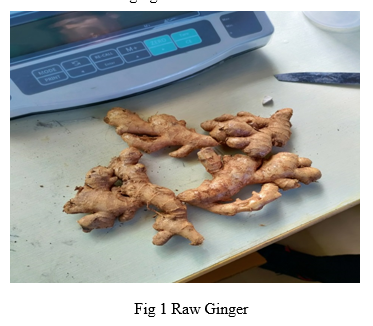
b. Cleaning
For making dried ginger after collection of Raw Ginger then cleaning it through water.
c. Peeling
Ginger is peeling after the process of Cleaning
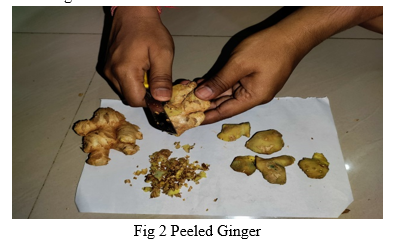
d. Washing
After peeled we wash the ginger again.
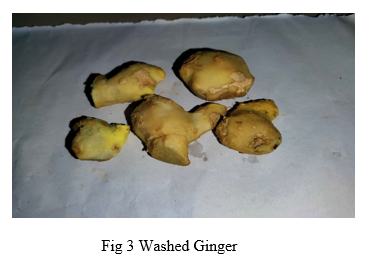
e. Cutting
After washing we cut Ginger into Small Pieces. So that the ginger piece will dry easily.
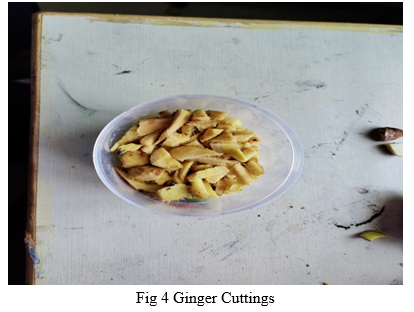
f. Drying
After completing all the process we put the ginger in Sun light.
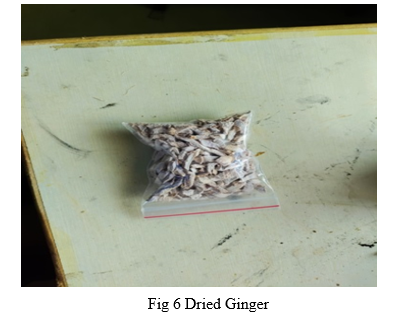
2. Making Candy Ginger
a. Fresh Raw Ginger
In first step we take raw ginger.
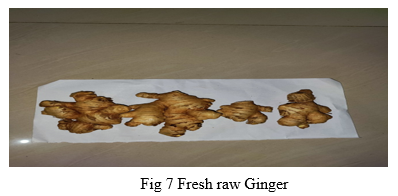
b. Cleaning
Raw ginger was purchased from the local market. It was cleaned and then used for further processing.
c. Peeling
Ginger is peeled after Cleaning
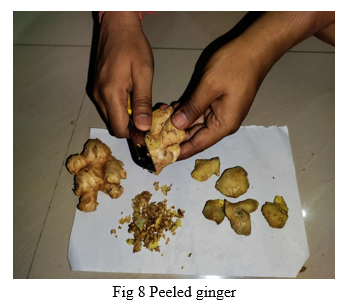
d. Washing
The Peeled ginger is again washed to remove some dust present.
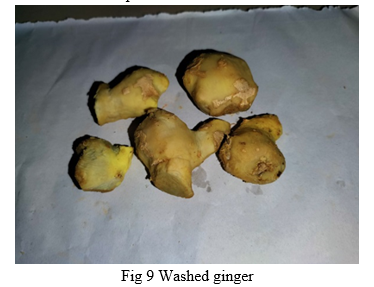
e. Cutting
After washing we have cut Ginger into Small Pieces. So that the ginger pieces will dry easily.
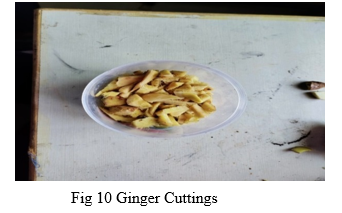
f. Grinded Ginger
The ginger is grinded roughly for easy formation of candy.
g. Ginger Candy
After completing all the process then cook the sugar with one-half glass of water then after the sugar is form in Semi-solid form then add the grind ginger in them .then cold this product for One day then Ginger candy has prepared.
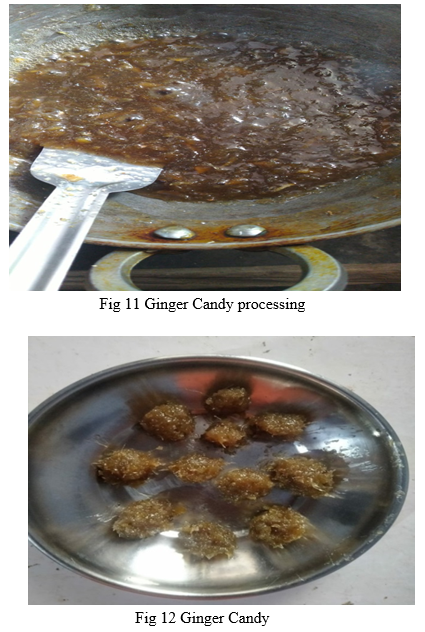
IV. RESULT AND DISCUSSION
Dried Ginger, when powdered, is an effective cure for indigestion, sore throat, cold and cough. It is used to treat nausea.
Using dried ginger is a better alternative to using ginger tea bags, which will often yield a flat and chalky brew. Ginger candy has ability to receive nausea is attributed to the way it expels intestinal gas and accelerates the movement of food out of your stomach. Candied ginger using such as ginger snaps, or quick breads like gingerbread, orange bread or banana bread. It can also use to spice up homemade pancakes and waffles.
|
Sl No. |
Raw Ginger |
Ginger Candy |
Cost |
|
1 |
250 g |
150 g |
Rs. 50 |
|
2 |
250 g |
150 g |
Rs. 35 |
References
[1] Abeysekera WKSM, Illeperuma CK, Amunugoda PNRJ, Wijeratnam S. (2005). Examination of ginger assortments dried at various temperatures for oil and oleoresin contents. Srilankan J Agric Sci. 42: 34-42 [2] Aderemi BO, Ndirika O, Yerima Y. (2009). Plan and creation of a medium-scale ginger pummeling machine for provincial occupants. Aus J Basic Appl Sci. 3(2): 389-394 [3] Agrawal YC, Hiran A, Galundia AS. (1987). Ginger stripping machine boundaries. Agric Mech Asia Africa Latin Amer. 18(2): 59-62 [4] Aggarwal BB, Shishodia S. (2006). Sub-atomic tar-gets of dietary specialists for counteraction and treatment of disease. Biochem Pharmacol. 71: 1397-1421. [5] Ahmed J. (2004). Rheological way of behaving and variety of changes of ginger glue during capacity. Int J Food Sci Technol. 39: 325-330 [6] Ahmed R, Sharma S. (1997). Biochemical examinations on the consolidated impact of garlic (Allium sativum L.) and ginger (Zingiber Officinalis) in pale-skinned person rodents. Ind J Experimental Biol, 3(5): 841-843. [7] Akande EA, Adeyanju JA, Oladipo OA, Oyetunji FF. (2014). Impacts of various bundling materials on the rack security of ginger juice. Greener Int J Sci, Engineering Technol Res. 4(2): 38-44 [8] Akhtar A, Dash PK, Mannan A. (2013). Physico-synthetic portrayal and item improvement from ginger (Zingiber officinale). Germplasm accessible in South Western Region of Bangladesh. [9] IOSR J Agric Vet Sci. 5: 53-62 [10] Alakali JS, Satimehin AA. (2009). Dampness adsorption qualities of ginger (Zingiber officinale) powders. Agric Engineering Int. 6: 1286-1291. [11] Alam P. (2013). Densitometric HPTLC examination of 8-gingerol in Zingiber officinale concentrate and ginger-containing dietary enhancements, teas, and business creams. Asian Pacific J Trop Biomedicine. 3(8):634-638. [12] Ali Y, Jain GC, Kapdi SS, Agrawal YC, Bhatnagar [13] S. (1991). Improvement of brush-type ginger stripping machine. Agric Mech Asia Africa Latin Amer. 22: 71-73 [14] Ali BH, Blunden G, Tanira MO, Nemmar A. (2008). Some phyto-substance, pharmacological and toxicological properties of ginger (Zingiber officinale Roscoe): a survey of late exploration. Food Chem Toxicology. 46(2):409-420. [15] Altman RD, Macrcussen KC. (2001). Impacts of ginger concentrate on knee torment in patients with osteoarthritis. J Phytomedicine. 44: 2531-2538 [16] Aruoma OI, Spencer JP, Warren D, Jenner P, Butler J, Halliwell B. (1997). The portrayal of food cancer prevention agents showed utilizing business garlic and ginger arrangements. Food Chem, 6: 49-156. [17] Arya PS. (2001). Ginger Production Technology. Kalyani Publishers New Delhi. 169p.
Copyright
Copyright © 2022 Avijeet Nayak, Debendra Pradhan, Dibyadarshan Nayak, Dr. Satyananda Swain, Prof. Gayatri Mohanty. This is an open access article distributed under the Creative Commons Attribution License, which permits unrestricted use, distribution, and reproduction in any medium, provided the original work is properly cited.

Download Paper
Paper Id : IJRASET42644
Publish Date : 2022-05-13
ISSN : 2321-9653
Publisher Name : IJRASET
DOI Link : Click Here
 Submit Paper Online
Submit Paper Online

